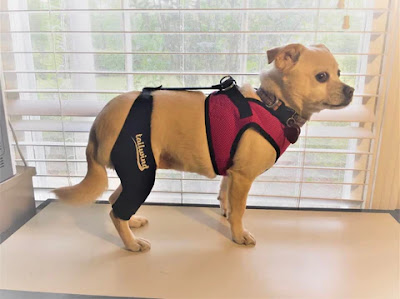Understanding CCL Injuries in Dogs
The CCL is
equivalent to the anterior cruciate ligament (ACL) in humans, and its main
function is to prevent excessive forward movement of the shin bone (tibia)
relative to the thigh bone (femur). When the CCL becomes injured or ruptured,
it leads to knee instability, resulting in pain, lameness, and limited joint
movement. CCL injuries can occur suddenly due to trauma or can develop
gradually over time due to wear and tear on the ligament.
How Dog Knee Braces Help in CCL Injury Treatment
Dog knee
braces, also known as cruciate ligament
braces or stifle braces, are designed to provide support and stability to the
knee joint affected by a CCL injury. While a dog
knee brace cannot replace a completely torn CCL, it can be an effective
treatment option for dogs with partial tears, mild to moderate injuries, or as
a supportive measure post-surgery. Here's how
dog knee braces help in CCL injury treatment:
- Stabilization: The primary purpose of a dog knee brace
is to stabilize the knee joint and limit excessive movement that can cause
further damage and inflammation. By providing support to the injured ligament,
the brace helps promote healing and reduce pain.
- Pain Relief: Dog knee braces help alleviate pain associated with CCL injuries by reducing
strain on the injured ligament and supporting the joint during movement.
- Improved Mobility: With increased stability and pain relief,
dogs can regain confidence in their movements, leading to improved mobility and
a better quality of life.
- Post-Surgery Support: For dogs undergoing surgical repair of the
CCL, knee braces can be used as part
of the post-operative recovery plan to protect the surgical site and aid in
rehabilitation.
Benefits of Dog Knee Braces for CCL Injuries
- Non-Invasive Treatment: Dog knee braces offer a non-invasive treatment option for CCL injuries,
providing support without the need for surgery.
- Cost-Effective: Compared to surgical intervention, knee braces are generally more
affordable, making them a cost-effective option for managing CCL injuries in
dogs.
- Customization: Many dog knee braces are adjustable and come in different sizes to fit various breeds
and sizes, ensuring a comfortable and customized fit for each dog.
- Rehabilitation Aid: Knee braces
for dogs can be used as part of a comprehensive rehabilitation program,
along with controlled exercises and physical therapy, to help dogs recover from
CCL injuries.
- Pain Management: Knee
braces provide pain relief, allowing dogs to move with less discomfort and
promoting a faster recovery.
Considerations when Using Dog Knee Braces
While dog knee braces can be beneficial for CCL
injury treatment, there are some considerations to keep in mind:
- Veterinary Consultation: Always consult with a veterinarian before
using a knee brace for
dog. They can assess the extent of the CCL injury and recommend the
most appropriate treatment plan.
- Proper Fit:
Ensure that the knee brace fits your
dog properly. An ill-fitting brace may cause discomfort and could potentially
do more harm than good.
- Gradual Introduction: Allow your dog time to get used to wearing
the knee brace. Start with short periods and gradually increase the duration to
ensure their comfort.
- Compliance:
Some dogs may be resistant to wearing a knee brace
initially. Encourage positive reinforcement and patience to help your dog
adjust to the brace.
Conclusion
CCL injuries
can significantly impact a dog's quality of life, but with the right treatment
and support, they can experience a successful recovery. Dog
knee braces offer a valuable non-invasive option for managing CCL
injuries, providing stability, pain relief, and improved mobility. While not
suitable for all cases, knee braces
can be an effective treatment for dogs with partial CCL tears or as part of a
comprehensive rehabilitation plan post-surgery. Always consult with a
veterinarian to determine the best course of action for your dog's specific
condition, and with proper care and attention, your furry companion can be on
the path to a happier and healthier life.










